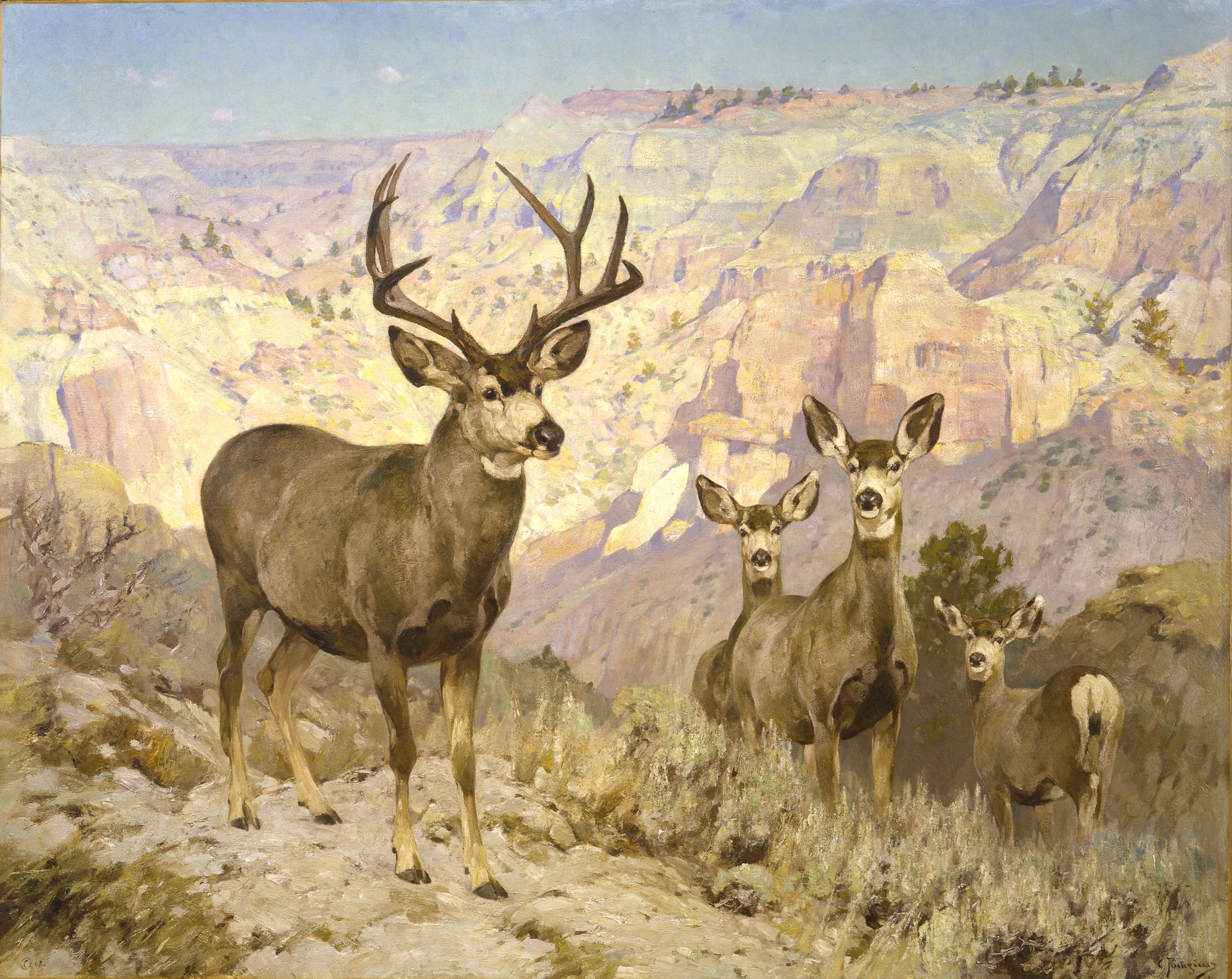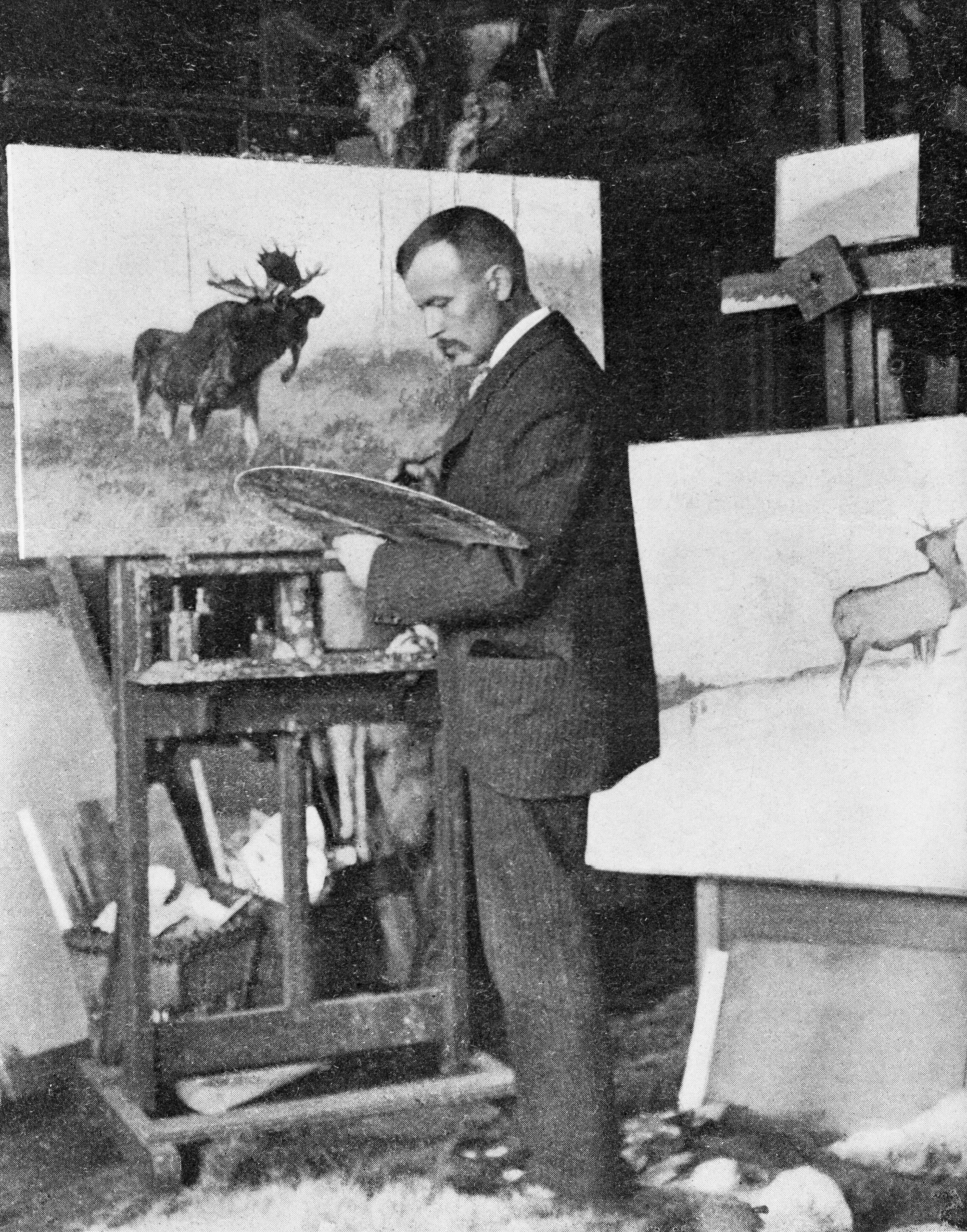A Sesquicentennial Celebration
May 7, 2019
Tuesday, May 7, 2019
The National Museum of Wildlife Art has the largest collection in the United States of work and artifacts by Carl Rungius, who is widely regarded as the greatest portrayer of North American big game animals ever. The Museum has the world’s only known complete set of Rungius’s 46 limited-edition engravings. To showcase the depth and diversity of its Rungius collection and to celebrate the 150th anniversary of Rungius’s birth (he was born in Germany in 1869), the Museum has curated two Rungius Sesquicentennial exhibitions: Rungius Reunited & Rarely Seen Rungius. Both exhibits opened May 4 and Rarely Seen Rungius includes pieces too fragile to be on long-term display.
“The work of Carl Rungius is incredibly important to our Museum, and the 150th anniversary of his birth is a great way to celebrate and bring recognition to this master of wildlife art,” says Dr. Adam Harris, the Museum’s Joffa Kerr Chief Curator of Art and a recipient of the Governor’s Arts Award, which recognizes substantial contributions made in Wyoming that exemplify a long-term commitment to the arts.
Rungius Reunited is the first time eight large paintings Rungius painted for the New York Zoological Society have been shown together since 1992. Between the 1955 and 1992, the eight paintings, then owned by the Rockefeller family, hung together at Jackson Lake Lodge in Grand Teton National Park. In 1994 the Rockefellers lent the eight paintings to two Wyoming museums: Cody’s Buffalo Bill Center of the West and the National Museum of Wildlife Art; each got four. The works were then gifted to the Museums in 1994. “For a curator, being able to reunite a group of paintings like this is really fun,” Harris says. “I think visitors will not only enjoy the display, but will also enjoy the story of how these paintings made their way from the Bronx to Jackson Lake Lodge to here.”
For Rarely Seen Rungius, the Museum pulled artworks and archival materials from its collection of 645 catalogued Rungius items including fragile photographs, letters, and artifacts and a newly donated Rungius painting of an African lion, Sultan. Also on display will be Old Baldface, a painting Rungius did of a grizzly bear in 1935, a sketch Rungius did of the painting, and an engraving of the same design. Harris says, “It is not often you get to see all of these works together in one place. It gives you a special insight into the artist’s methods that only comes with viewing these works firsthand.”
The Museum credits its founders Bill & Joffa Kerr for the excellence and depth of its collection of Rungius works and artifacts, especially the artist’s engravings. When it opened in 1987, exhibiting artworks mostly from the Kerrs’ collection, the Museum had copies of most of Rungius’s 46 engravings, although it did not have the rarest, In Fighting Mood. In 1994, when the Museum moved to its current location north of Jackson, Museum Trustees presented the Kerrs with the missing engraving for the Museum. (In Fighting Mood is included in Rarely Seen Rungius.) “It would take a long, long time and a lot of resources to duplicate what we have here—if it could even be done,” says Harris about the Museum’s Rungius collection.
Carl Rungius was born and raised in Berlin, Germany, and came to America in 1894 at age 25 with his uncle; the two hunted moose in Maine. The following year Rungius traveled to Wyoming for the first time—he stayed at the Box R dude ranch on the western flanks of the Wind River Mountains—and that was the start of a lifelong love for the Rocky Mountains. Every summer thereafter until his death in 1959 he traveled to the Rocky Mountains to hunt and paint.
The National Museum of Wildlife Art wishes to thank the Buffalo Bill Center of the West in Cody, Wyoming, for generously lending its major Rungius paintings for display in Rungius Reunited.
Rarely Seen Rungius hangs through August 25, and Rungius Reunited through October 13.
Rungius Sesquicentennial – Rungius Reunited & Rarely Seen Rungius is generously sponsored by: Elizabeth & Thomas Grainger, Gloria & Bill Newton, Anne & Michael Moran, and Tally & Bill Mingst.


Left Photo: Carl Rungius (1869–1959). Mule Deer in the Badlands, Dawson County, Montana, 1914. Oil on canvas, 59.625 x 75.25 inches. Buffalo Bill Center of the West, Cody, WY. Gift of Jackson Hole Preserve, Inc. 16.93.2
Right Photo: Photograph courtesy of Glenbow Archives, NA-789-70.
The National Museum of Wildlife Art, a nonprofit founded in 1987, is a world-class art museum holding more than 5,000 artworks representing wild animals from around the world. Featuring work by prominent artists such as Georgia O’Keeffe, Andy Warhol, Robert Kuhn, John James Audubon, and Carl Rungius, the Museum’s unsurpassed permanent collection chronicles much of the history of wildlife in art, from 2500 B.C. to the present. Built into a hillside overlooking the National Elk Refuge, the Museum received the designation “National Museum of Wildlife Art of the United States” by order of Congress in 2008. Boasting a Museum shop, interactive children’s gallery, Palate restaurant, and outdoor sculpture trail, the Museum is only two-and-a-half miles north of Jackson Town Square, and two miles from the gateway of Grand Teton National Park. www.WildlifeArt.org
IMAGES AND INTERVIEWS AVAILABLE ON REQUEST
Media Contact: Taylor Woods, Marketing Manager, (307)732-5437, twoods@wildlifeart.org